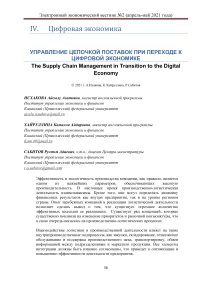Управление цепочкой поставок при переходе к цифровой экономике
Автор: Ихакова Айсылу Азатовна, Хайруллина Камилла Айдаровна, Сабитов Рустэм Адиевич
Журнал: Электронный экономический вестник Татарстана @eenrt
Рубрика: Цифровая экономика
Статья в выпуске: 2, 2021 года.
Бесплатный доступ
Эффективность и экологичность производства компании, как правило, является одним из важнейших параметров, обеспечивающих высокую производительность. В настоящее время производственно-логистическая деятельность взаимозависимы. Кроме того, они могут определять динамику финансовых результатов как внутри предприятия, так и на уровне регионов страны. Опыт зарубежных компаний в реализации логистической деятельности позволяет сделать вывод о том, что существует огромное количество эффективных подходов ее реализации. Существует ряд концепций, которые существенно повлияли на изменение приоритетов и рыночной конъюнктуры, что в свою очередь сказалось на производственно-логистических процессах. Взаимодействие логистики и производственной деятельности влияет на такие внутрипроизводственные подпроцессы, как закупки, складирование, техническое обслуживание и поддержка производственного цеха, транспортировку, обмен информацией между подразделениями и маркетинг продукции. Все элементы интеграции должны быть взаимно согласованы, что приведет к оптимизации и повышению эффективности деятельности предприятия.
Цифровое управление поставками, цифровая экономика, влияние, развитие экономики
Короткий адрес: https://sciup.org/143178074
IDR: 143178074
Список литературы Управление цепочкой поставок при переходе к цифровой экономике
- Ala-Risku, T. et al. (2010) ‘Site inventory tracking in the project supply chain: Problem description and solution proposal in a very large telecom project’, Supply Chain Management. doi: 10.1108/13598541011040008.
- Armbrust, M. et al. (2010) ‘A view of cloud computing’, Communications of the ACM. doi: 10.1145/1721654.1721672.
- Baumers, M. and Holweg, M. (2019) ‘On the economics of additive manufacturing: Experimental findings’, Journal of Operations Management. doi: 10.1002/joom.1053.
- Cagliano, A. C., De Marco, A. and Rafele, C. (2017) ‘E-grocery supply chain management enabled by mobile tools’, Business Process Management Journal. doi: 10.1108/BPMJ-01-2016-0002.
- Dunn, G. (2016) The Frictionless Organization: A Six-Step Plan to Reduce Friction - DOCUMENT Strategy Media. Available at: https://documentmedia.com/article-2525-The-Frictionless-Organization-A-Six-Step-Plan-to-Reduce-Friction.html.
- Fawcett, S. E. and Waller, M. A. (2014) ‘Supply chain game changersmega, nano, and virtual trends-and forces that impede supply chain design (i.e., Building a Winning Team)’, Journal of Business Logistics. doi: 10.1111/jbl.12058.
- Ferrantino, M. J. and Koten, E. E. (no date) Understanding Supply Chain 4.0 and its potential impact on global value chains.
- Garay-Rondero, C. L. et al. (2019) ‘Digital supply chain model in Industry 4.0’, Journal of Manufacturing Technology Management. doi: 10.1108/JMTM-08-2018-0280.
- Kache, F. and Seuring, S. (2017) ‘Challenges and opportunities of digital information at the intersection of Big Data Analytics and supply chain management’, International Journal of Operations and Production Management. doi: 10.1108/IJOPM-02-2015-0078.
- Kamal, M. M. and Irani, Z. (2014) ‘Analysing supply chain integration through a systematic literature review: A normative perspective’, Supply Chain Management. doi: 10.1108/SCM-12-2013-0491.
- Korpela, K., Hallikas, J. and Dahlberg, T. (2017) ‘Digital Supply Chain Transformation toward Blockchain Integration’, in Proceedings of the 50th Hawaii International Conference on System Sciences (2017). doi: 10.24251/hicss.2017.506.
- Sasson, A. and Johnson, J. C. (2016) ‘The 3D printing order: variability, supercenters and supply chain reconfigurations’, International Journal of Physical Distribution and Logistics Management. doi: 10.1108/IJPDLM-10-2015-0257.
- Supply Chain 4.0 - Manufacturing Solutions | Future of Possibilities - Think Ahead : Social Innovation : Hitachi (no date). Available at: https://socialinnovation.hitachi/en-us/think-ahead/manufacturing/supply-chain-4-0/.14. Supply Chain 4.0 – the next-generation digital supply chain | McKinsey (no date). Available at: https://www.mckinsey.com/business-functions/operations/our-insights/supplychain-40--the-next-generation-digital-supply-chain.
- Swanson, D. (2017) ‘The Impact of Digitization on Product Offerings: Using Direct Digital Manufacturing in the Supply Chain’, in Proceedings of the 50th Hawaii International Conference on System Sciences (2017). doi: 10.24251/hicss.2017.508.
- De Treville, S., Shapiro, R. D. and Hameri, A. P. (2004) ‘From supply chain to demand chain: The role of lead time reduction in improving demand chain performance’, Journal of Operations Management. doi: 10.1016/j.jom.2003.10.001.
- Vendrell-Herrero, F. et al. (2017) ‘Digital dark matter within product service systems’, Competitiveness Review. doi: 10.1108/CR-11-2014-0037.
- Xue, L. et al. (2013) ‘Risk mitigation in supply chain digitization: System modularity and information technology governance’, Journal of Management Information Systems. doi: 10.2753/MIS0742-1222300110.


